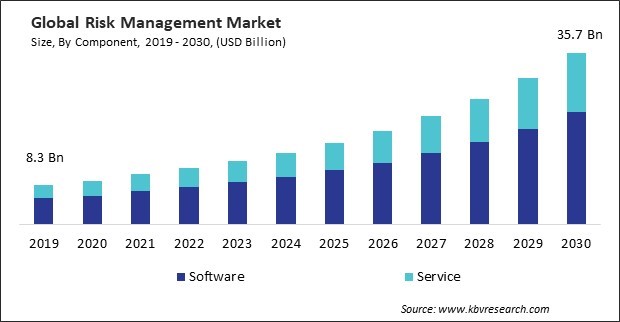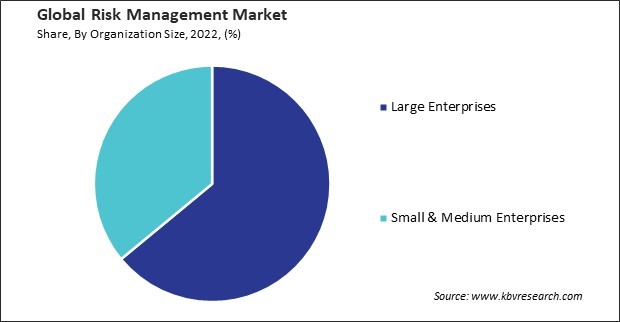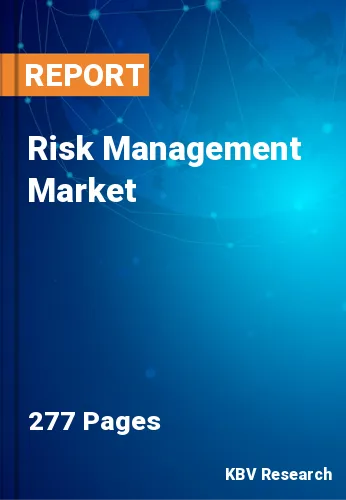“Global Risk Management Market to reach a market value of USD 35.7 Billion by 2030 growing at a CAGR of 15.2%”
The Global Risk Management Market size is expected to reach $35.7 billion by 2030, rising at a market growth of 15.2% CAGR during the forecast period.
Monitor and respond to consumer feedback to address issues promptly and protect the brand's reputation. They were developing strategies for effective communication during crises to manage public perception and maintain customer loyalty. Consequently, the movie characters segment would generate approximately 13.86% share of the market by 2030. Managing credit risk associated with customer transactions, particularly in cases of extended credit terms or installment payments. International retailers were managing currency exchange rate risks to avoid financial losses.

The complexity of these regulations creates an opportunity for risk management solutions to provide tools that streamline compliance processes, track regulatory changes, and ensure adherence to diverse compliance requirements. Thus, stringent regulatory compliance requirements act as a driving force for expanding the market. Moreover, Globalization leads to businesses engaging in diverse markets, which exposes them to various risks, such as geopolitical, economic, and regulatory. This diversification creates a higher demand for sophisticated risk management strategies and solutions. Cross-border operations often involve dealing with different legal, cultural, and regulatory environments. Thus, globalization and cross-border operations have expanded the market.
However, the speed at which risks evolve in a complex and dynamic environment can outpace the ability of traditional risk management models and tools to adapt. This can result in outdated risk assessments and strategies that fail to address emerging threats. The complexity of the business landscape makes it challenging to identify and anticipate emerging risks. Due to the above factors, market growth will be hampered in the coming years.
Based on component, the market is fragmented into service and software. The service segment garnered a significant revenue share in the market in 2022. Risk assessment and consulting services provide organizations with the expertise to conduct comprehensive risk assessments. Experienced consultants analyze the unique risk landscape of a business, identify potential threats, and recommend tailored strategies to enhance resilience. This service component ensures that risk management strategies align with the distinct needs and goals of the organization. Financial risk management advisory services give organizations insights into market fluctuations, credit risks, and liquidity challenges. Experts in financial risk management guide businesses in optimizing investment strategies, hedging against financial uncertainties, and ensuring financial stability.
On the basis of deployment model, the market is segmented into on-premises and cloud. In 2022, the on-premises segment dominated the market with the maximum revenue share. On-premises deployment affords organizations greater control over their data governance policies. This is mainly crucial in industries where data privacy and confidentiality are paramount. Organizations can implement robust data governance measures, including encryption, access controls, and auditing, to safeguard sensitive risk-related information. On-premises deployment ties the performance and scalability of risk management systems to the organization's internal network infrastructure. This can pose challenges in rapidly scaling resources or adapting to dynamic workloads. Organizations must carefully plan and invest in scalable infrastructure to accommodate future growth and changing requirements.
By organization size, the market is categorized into large enterprises and small & medium enterprises. The small & medium enterprises segment recorded a remarkable revenue share in the market in 2022. SMEs can optimize their insurance coverage by understanding their risks. This helps in avoiding over-insurance or under-insurance, ensuring cost-effectiveness and appropriate coverage. SMEs can use risk management to identify operational risks, such as process inefficiencies, technology failures, or human errors. Addressing these risks enhances overall operational efficiency. SMEs often face credit, cash flow, and financial stability challenges. Risk management can help identify and manage these risks, ensuring the business's financial health.

On the basis of vertical, the market is BFSI, IT & telecom, retail, healthcare & lifesciences, energy & utilities, manufacturing, government & defense, and others. In 2022, the BFSI segment witnessed the largest revenue share in the market. Banks assess the creditworthiness of borrowers to manage the risk of default. This involves analyzing financial statements, credit history, and collateral to make informed lending decisions. Financial institutions manage the risk arising from fluctuations in interest rates, exchange rates, and market prices of securities by aligning their assets and liabilities. BFSI entities often use derivatives to hedge against market risks, especially regarding currency and interest rate exposures. Offer insurance products to customers and utilize reinsurance to transfer some of the risks associated with underwriting.
Free Valuable Insights: Global Risk Management Market size to reach USD 35.7 Billion by 2030
Region-wise, the market is analysed across North America, Europe, Asia Pacific, and LAMEA. The Asia Pacific region garnered a significant revenue share in the market in 2022. Regulatory frameworks in the Asia Pacific region are evolving to address emerging risks and protect various stakeholders. Compliance with regulations related to financial services, data privacy, and cybersecurity is crucial, leading to increased adoption of risk management solutions. There is a cultural shift toward recognizing the value of risk management as a strategic business function. Organizations acknowledge the need to manage risks to achieve long-term sustainability and resilience proactively.
| Report Attribute | Details |
|---|---|
| Market size value in 2022 | USD 11.8 Billion |
| Market size forecast in 2030 | USD 35.7 Billion |
| Base Year | 2022 |
| Historical Period | 2019 to 2021 |
| Forecast Period | 2023 to 2030 |
| Revenue Growth Rate | CAGR of 15.2% from 2023 to 2030 |
| Number of Pages | 277 |
| Number of Tables | 460 |
| Report coverage | Market Trends, Revenue Estimation and Forecast, Segmentation Analysis, Regional and Country Breakdown, Porter’s 5 Forces Analysis, Company Profiling, Companies Strategic Developments, SWOT Analysis, Winning Imperatives |
| Segments covered | Component, Deployment Model, Organization Size, Vertical, Region |
| Country scope |
|
| Companies Included | RSA Security LLC (Symphony Technology Group), IBM CorporationSAS Institute, Inc., SAP SE, ServiceNow, Inc., Qualys, Inc., Thomson Reuters Corporation (The Woodbridge Company), NAVEX Global, Inc. (Lockpath), MetricStream, Inc., LogicManager, Inc. |
By Component
By Deployment Model
By Organization Size
By Vertical
By Geography
This Market size is expected to reach $35.7 billion by 2030.
Stringent regulatory compliance requirements are driving the Market in coming years, however, Increasingly complex and dynamic restraints the growth of the Market.
RSA Security LLC (Symphony Technology Group), IBM CorporationSAS Institute, Inc., SAP SE, ServiceNow, Inc., Qualys, Inc., Thomson Reuters Corporation (The Woodbridge Company), NAVEX Global, Inc. (Lockpath), MetricStream, Inc., LogicManager, Inc.
The expected CAGR of this Market is 15.2% from 2023 to 2030.
The Large Enterprises segment is leading the Market by Organization Size in 2022, there by, achieving a market value of $21.7 Billion by 2030.
The North America region dominated the Market by Region in 2022 there by, achieving a market value of $12.7 Billion by 2030, growing at a CAGR of 14.4 % during the forecast period.
Our team of dedicated experts can provide you with attractive expansion opportunities for your business.

 Drivers
Drivers
 Restraints
Restraints
 Opportunities
Opportunities
 Challenges
Challenges
